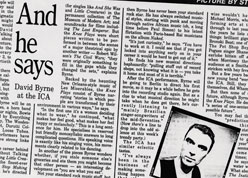ORIGINAL
PRESS CLIPPINGS

A LIGHTHANDED MIX OF ELEGANCE AND EARTHINESS
Of course, they're not supposed to be meals, just appetizers, announcing each piece of the larger work, not duplicate it in depth or scale. Strung together, they serve as a précis of the metaphysical action — if one can call it that — in the larger-spanned whole. Although "the Knee Plays" are performed by dancers, its principals are objects charged with the magic of children's theater when it's going right — a tree, a book, a boat, a ladder. The tree is a T-shaped structure of interlocking muslin-covered cubes. In it, reading a book, sits a Bunraku puppet, a golden-headed stick figure borne aloft on bamboo rods by stagehands whose presence we are not supposed to notice. Lightning hits the tree, it falls, dissolves into logs, which become a cabin, and the cycle begins. A boat is built, a large skeletal bird plucks a passenger from it, projections of graffiti appear upstage, Laurie Anderson style, and the fable-like action continues to be played out against a background of David Byrne lyrics that will sound familiar to anyone who has seen "Stop Making Sense," and to Byrne's brass music that humorously undercuts the ethereal Japanese visual esthetic by aping New Orleans jazz.
It's a cheeky and often amusing multitrack experience that arises from the combination of Wilson's movements, the Japanese ambience, Byrne's tense, clipped lyrics, and the Dixieland. Because the duration of each episode is so short, Wilson is unable to expand time the way he likes to do. But he does nudge the action and the principals, be they objects or personages, into the floating world of Japanese fiction. When, in play number 7, an Admiral Perry figure arrives and performs a puppet show for the Japanese, the unlikely yet natural-seeming entwining of the two cultures becomes an implication made flesh.
From that point on, the images and episodes take on greater impact. In episode 9, a basket-seller sets down two fat bales of brooms and baskets, and they take on a life of their own, tipsily dancing. Number 10, like the German section, evokes Matthew Brady's Civil War photographs, as two tents, lit from inside, expand and slowly drift toward one another. The historical echoes add dimension to "the Knee Plays," and if their substance tends more toward parable than myth, there's a satisfying sense of a circle being closed, after a figure wearing a white plaster head evoking a baby Buddha is led to a chair and a book, which finally turns back into the tree that started the whole thing.